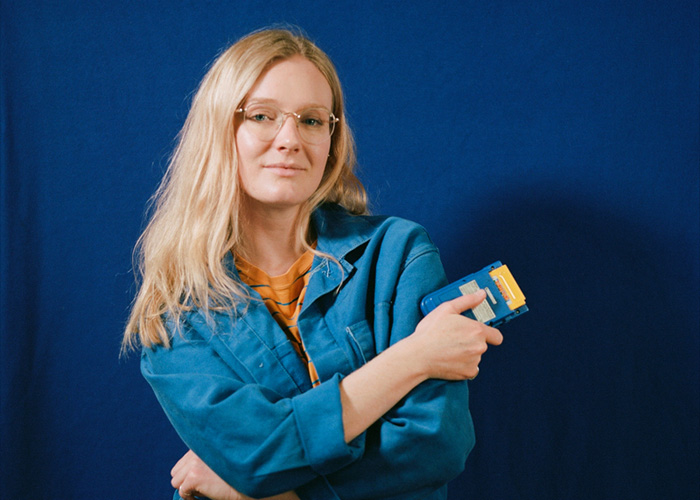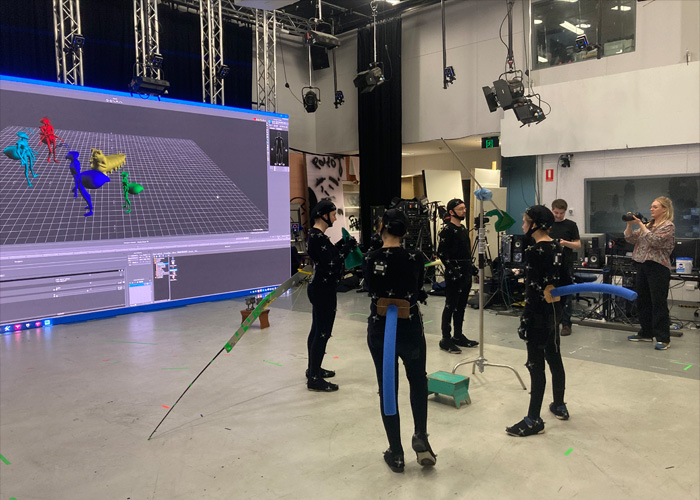
In her project titled Herding Caterpillars, Assemblage Centre for Creative Arts’ 2022 Digital and Environmental Artist in Residence Rosina Possingham has digitised a play about the symbiotic relationship between the Chequered Copper Butterfly, the native Oxalis plant, and the Black Ant.
As part of the Crea Tech City Challenge funded by the Capital City Committee Development Program, Rosina worked on this virtual reality (VR) and augmented reality (AR) project in collaboration with The Void, Flinders’ motion capture and virtual production studio, and CDW Animation, the animation studio connected to Flinders’ visual effects and entertainment design partners CDW Studios.
The idea behind Herding Caterpillars
After completing a Bachelor of Design (Visual Communication) and a Master of Visual Art and Design – Graphic Design, Rosina went on to work in graphic design, photography and art projects. One of these projects was a show involving 3D scans from the parklands in which the Chequered Copper Butterfly had originally been rediscovered.
“This butterfly only lays its eggs on the Oxalis plant, and only if Black Ants are present. The ants raise the caterpillar by taking it down into their tunnel and up to feed before the caterpillar goes into the chrysalis and then turns into the butterfly. The butterfly is rarely seen nowadays as the paddocks in which Oxalis plants grow have largely been destroyed.”
Through her friend and photography collaborator, Brianna Speight, who works at Flinders University Museum of Art, Rosina found out about the Artist in Residence Program at Flinders. “I pitched VR world-building of a patch of gum trees in Victoria Park. I wanted to scan the area and then create motion capture recordings to add into that 3D world.
“The team really liked my idea, but I was right at the beginning of my project and hadn’t scanned anything yet. I knew that I wanted to use the tech in the Void, but my project needed many more considerations to have the best outcome.” Rosina’s first attempt at securing the residency wasn’t successful but she decided to apply again the following year.
Rosina’s second application attempt
Rosina started working on Herding Caterpillars with Butterfly Conservation SA’s chairman Gerry Butler 5-6 months before she applied again. Gerry had directed a 5-minute play about the symbiotic relationship between the butterfly, ant and plant alongside Rosina’s godmother and environmental educator Jackie Hunter. The play involved 5 actors and it just so happened that there were 5 motion capture suits in the Void.
Gerry was keen on reimagining the play in VR and Rosina thought it would be possible to record the 5-minute show in the month of her potential residency. Little did Rosina know that creating a digital version of the play the way she envisioned it would take months.
“From creating 3D models, turning them into so-called rigs that then need to be animated with the motion capture suits to adding in sound, collecting face data from all the actors, etc. – there were lots of jobs I didn’t know about. This was a major production. And I needed help.
“I essentially spent my residency figuring out what I needed to do with Senior Lecturer in Visual Effects and Entertainment Design Jason Bevan and Lead Technician Cameron Mackness from The Void and when I was ready, CDW Animation and The Void came on board as major partners for the project. CDW Animation stepped in with the concept artists and animators and created the digital assets. The Void provided the technology needed for motion capture and virtual production.”

Creating Herding Caterpillars
Putting the virtual production together truly was a team effort with many moving parts. Rosina couldn’t have been happier with the team she had to support her.
“James Marshall, CDW’s Head of Studio, believed in me right from the start. CDW’s rigger Tyler Oppermann-Allen was really crucial for us. His job was to make sure that wherever the body in the motion capture suit moves, the ant is moving the correct parts. This was hard because the ant had second limbs and the caterpillar had a long back. Tyler animated the back of the caterpillar to move in the rig so that the animators had less work to do. One of my requirements was that it stayed as much motion capture as possible because I wanted the production to have human elements.
“I started not knowing anything and I just learnt so much from Cam and Jason. I thought I knew a lot from watching Liam Somerville who was Assemblage’s Artist in Residence in 2021. I’d contacted him and asked if I could watch his work. He happily invited me into the Void.
“But I soon learnt that each project needs completely new solutions. I needed some time in The Void myself to be able to answer questions like where I’d be in week ‘X’. I learnt so much and the technology changes all the time.
“As an example, we worked with ‘Victor’ who is a pre-download rig from Vikon. When I started Jason told me there is no way you can change the ants’ faces and we had to buy Victor. Then the next week I came in and Jason told me new tech had been released. Tyler had been working on the project Big Sand with Sally Coleman. We shared the Void for research and development and were able to collaborate sometimes by, for example, my actors testing her suits for the following day.
“Sally needed to drive her main character’s face so Tyler had been working on alternative solutions to do so. I really needed my butterfly to be sassy, she needed a face. I was then able to use that tech that Tyler had discovered.
“Those chats with Jason and the team were invaluable to me. The tech moves so fast and you think something can’t be done or it’s just not feasible. And then, literally within a week or two, the tech has changed or someone has released a new update.
“Assemblage Director Dr Tully Barnett also supported me from day one. I rang her when I first saw the call out for the following year and she told me just to apply. She made me feel like my project was valid the whole time.”
Where Herding Caterpillars can be experienced
Herding Caterpillar’s VR experience was presented at the Institute Building in the Adelaide’s State Library and was then combined with the AR experience in front of the SA Museum, in front of MOD and in Victoria Park in the Parklands – all as part of the 2022 Adelaide Nature Festival.
“The first flight of these butterflies is in October and Adelaide Nature Festival was on from 6th-16th of October. So the timing was just perfect. We ran live events with scientists out in the Parklands and brought an extended reality (XR) experience to the main public in the city. The Chequered Copper Butterfly is tiny and we made it big and really sassy so people would become more aware of her.
“I had several conversations with Tully about anthropomorphism – the attribution of human characteristics or behaviour to objects. That way, we as humans will care more for conservational causes.
“Because they’ve experienced this little story in a different way with crazy tech, Gerry and I hope the audiences will be excited to go and spend that little bit more time in nature – maybe even see if they can find the Chequered Copper Butterfly themselves or want to conserve a little bit more land for the Oxalis plant that we need to make this butterfly work.”
“These multidisciplinary, collaborative, innovative projects showcase that technology can be used for good, for fun. It’s not a gaming experience that needs to be sat on in a room for hours. It can get people outdoors and be downloaded for free in the Oculus Store.”

Rosina’s advice to creative arts students
Having a multidisciplinary approach herself, Rosina believes the best thing Creative Arts students can do, is participate in multidisciplinary projects. “Work with other creatives and jump on board when it comes to networking and working on extracurricular projects like this one. Give it a go.
“If I was a student at Flinders, I would put my hand up for things, even though it is more work, and you might have to lose a shift in your retail job. But you’ll gain from the experience long term. There are a lot of students with the same portfolios, but if someone has got real-life project experience, that will make you stand out.”
“I’ve always continued studying and looked at finding mentors that can help me learn new skills. I reconnect with them quite often. If you’ve made a connection, go back and ask if you can assist with a new project.
“Also find out which creative jobs are lacking staff and be open to them. There are so many creative tech jobs and people don’t realise how much maths is involved in them. You might sign up as an artistic person. But here quite logical people are needed. The creative arts need all kinds of different types of brains.
“You might love concept art, but there might be a lot more jobs going in rigging. So maybe go and specialise in something for a little bit, even if you don’t think you love it. Give it a go and see what it’s about. You could even ask local studios whom they are looking for.
“In the areas in which creative employers are really needing people now, you can get jobs without even being the best in your class. Lots of riggers get hired straight out of the classroom because there just aren’t enough in Adelaide. Or the world. Niche jobs have a huge potential and many people aren’t aware of them.
Enter Flinders’ creative world
Interested in working on projects like Rosina Possingham? Flinders offers a range of Creative Arts degrees covering Virtual Production, Visual Effects and Entertainment Design, Gaming and many more.
Or are you an artist who is interested in working in our motion capture and virtual production studio or becoming our next Artist in Residence? Then contact The Void or Assemblage. We look forward to hearing from you.

